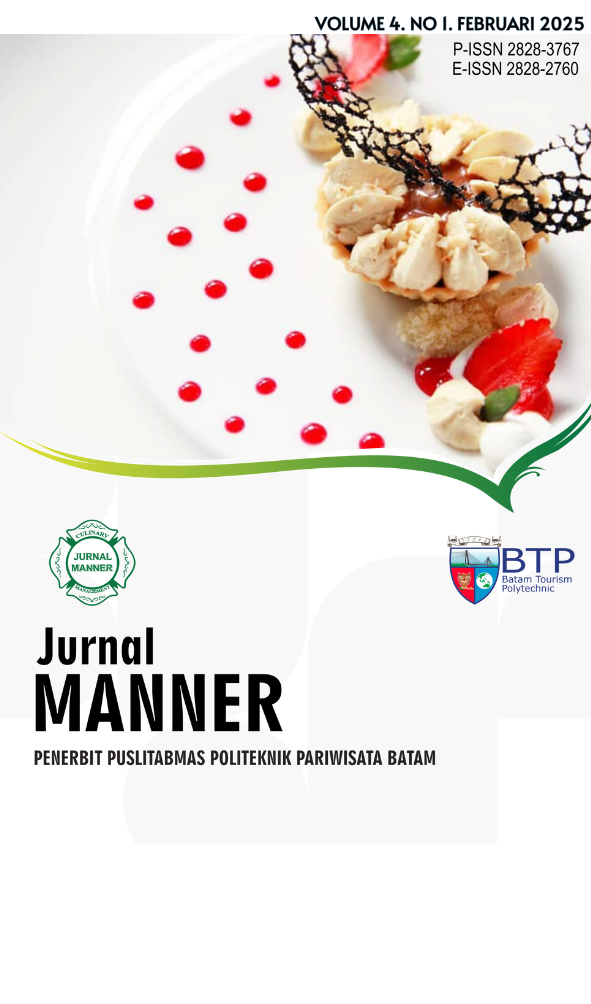GUDEG AND KIMCHI: EXPLORING THE UNIQUENESS OF TRADITIONAL JAVANESE AND KOREAN CUISINE
DOI:
https://doi.org/10.59193/jmn.v4i1.364Keywords:
Gudeg, Yogyakarta, Kimchi, Korea, Traditional FoodAbstract
Every society in the world has a traditional cuisine. Traditional cuisine reflects the history, uniqueness, and culture of a society. One example of a traditional cuisine is gudeg from Yogyakarta and kimchi from Korea. Both are traditional cuisines that have been recognized by UNESCO as intangible heritage. The purpose of this research is to compare the similarities and differences between gudeg and kimchi. The method used is qualitative method. The data collection technique is a literature study by reading and understanding from books, journals or articles relevant to the theme. As a result, the similarities between gudeg and kimchi are that they both come from vegetables, are processed for a long time, and become icons of each region. The difference is that the taste, color, and texture of these two dishes are different. In conclusion, these two dishes are created by the adaptation of the community with the environment in which they live by creating traditional foods with distinctive flavors. The contribution of this research provides an understanding of traditional cuisine from various regions.
Downloads
References
Akyuni, Q., Putri, F. R., Annisa, N., & Fevria, R. (2022). Pembuatan Kimchi Berbahan Dasar Sawi Putih (Brassica pekinensia L.). Prosiding Seminar Nasional Biologi, 2(1), 492–498. https://doi.org/10.24036/prosemnasbio/vol2/414
Bumbu, T. (2023). Masakan Jawa: Kelezatan Tradisi Kuliner Nusantara. Tiram Media.
Cha, J., Kim, Y. B., Park, S.-E., Lee, S. H., Roh, S. W., Son, H.-S., & Whon, T. W. (2024). Does Kimchi Deserve The Status Of A Probiotic Food? Critical Reviews in Food Science and Nutrition, 64(19), 6512–6525. https://doi.org/10.1080/10408398.2023.2170319
Disperindag DIY Targetkan Bisa Ekspor Gudeg ke Arab Saudi Tahun Depan—Tribunjogja.com. (2024). Diambil 21 Januari 2025, dari https://jogja-tribunnews-com.
Dylanesia, W. (2024). Ensiklopedia Makanan Khas Jawa. Penerbit Andi.
Enjelly, Radhifah, Fauzia, S. H., & Fevria, R. (2022). Peranan Fermentasi dalam Proses Pembuatan Kimchi Sawi Putih (Brassica chinensis L.) dan Mentimun (Cucumis sativus L.). Prosiding Seminar Nasional Biologi, 2(2), 471–476. https://doi.org/10.24036/prosemnasbio/vol2/472
H, S. B. S. N. M., & Faujania, D. M. (2024). Studi Literatur: Kualitas Kimchi Berdasarkan Lama Fermentasi. Media Ilmiah Teknologi Pangan (Scientific Journal of Food Technology), 11(1), 36–40. https://doi.org/10.24843/MITP.2024.v10.i01.p36-40
Imatome-Yun, N. (2015). Seoul Food Korean Cookbook: Korean Cooking from Kimchi & Bibimbap to Fried Chicken & Bingsoo. Sourcebooks, Inc.
Jang, D.-J., Chung, K. R., Yang, H. J., Kim, K., & Kwon, D. Y. (2015). Discussion On The Origin Of Kimchi, Representative Of Korean Unique Fermented Vegetables. Journal of Ethnic Foods, 2(3), 126–136. https://doi.org/10.1016/j.jef.2015.08.005
Juniarti, S., Hidayat, A., & Safitri, P. (2021). Analisis Strategi Gastrodiplomasi Korea Selatan dari Segi Peningkatan Kunjungan Wisatawan Asing di Korea Selatan (2014-2019). Indonesian Journal of Global Discourse, 3(1), 20–34. https://doi.org/10.29303/ijgd.v3i1.30
Kurniawati, L. S. M. W., & Marta, R. F. (2021). Menelisik Sejarah Gudeg Sebagai Alternatif Wisata Dan Citra Kota Yogyakarta. Sejarah dan Budaya: Jurnal Sejarah, Budaya, dan Pengajarannya, 15(1), 26–35. https://doi.org/10.17977/um020v15i12021p26-35
Kusumawati, P., Tyas, D. W., Fitriana, F., & Kusumaningrum, H. (2023). Oleh-Oleh Makanan Khas Daerah Istimewa Yogyakarta Sebagai Daya Tarik Wisata Ekonomi. Pringgitan, 4(2), 40–56. https://doi.org/10.47256/prg.v4i2.350
Kwon, D. Y., Soon-Hee, K., Chung, K. R., Daily, J. W., & Park, S. (2023). Science And Philosophy Of Korea Traditional Foods (K-Food). Journal of Ethnic Foods, 10(1), 26. https://doi.org/10.1186/s42779-023-00194-3
Lestari, L. A., Lestari, P. M., & Utami, F. A. (2018). Kandungan Zat Gizi Makanan Khas Yogyakarta. UGM PRESS.
Martins, N., & Brandão, D. (2023). Advances in Design and Digital Communication IV: Proceedings of the 7th International Conference on Design and Digital Communication, Digicom 2023, November 9–11, 2023, Barcelos, Portugal. Springer Nature.
Prakoso, P. (2012). Masakan Jepang dan Korea. DeMedia.
Putri, I. P., Liany, F. D. P., & Nuraeni, R. (2019). K-Drama dan Penyebaran Korean Wave di Indonesia. ProTVF, 3(1), 68–80. https://doi.org/10.24198/ptvf.v3i1.20940
Rukin. (2021). Metodologi Penelitian Kualitatif Edisi Revisi. Surabaya: Jakad Media Publishing.
Santoso, U., Gardjito, M., & Harmayani, E. (2019). Makanan Tradisional Indonesia Seri 2: Makanan Tradisional yang Populer (Sup, Mi, Set Menu Nasi, Nasi Goreng, dan Makanan Berbasis Sayur). UGM PRESS.
Surya, R., & Lee, A. G.-Y. (2022). Exploring The Philosophical Values Of Kimchi And Kimjang Culture. Journal of Ethnic Foods, 9(1), 20. https://doi.org/10.1186/s42779-022-00136-5
Susanti, D. A., Ma’arif, S., Nurhayati, E., Zulmarihana, D., & Dharu, A. R. (2022). Perancangan Desain Kemasan Gudeg Jogja dengan Menggunakan Metode Quality Function Deployment (QFD). Jurnal Engine: Energi, Manufaktur, Dan Material, 6(2), 64–69. https://doi.org/10.30588/jeemm.v6i2.1359
Teiseran, A. A. U., Cicilia, Natalia, P., Christian, V. N., Miharti, Y., & Rukmini, E. (2022). The Differences Of Sensory Quality In Kimchi From Korea And Indonesia: A Systematic Review. IOP Conference Series: Earth and Environmental Science, 1116(1), 012005. https://doi.org/10.1088/1755-1315/1116/1/012005
Wijayanti, A. (2020). Wisata Kuliner sebagai Strategi Penguatan Pariwisata di Kota YOGYAKARTA, Indonesia. Jurnal Khatulistiwa Informatika, 11(1), 74–82. https://doi.org/10.31294/khi.v11i1.7998
Williams, B. (2024). Kimchi Magic: A Step-by-Step Guide to Making and Incorporating Kimchi into Your Diet. Barrett Williams.
Yudhistira, B. (2022). The Development And Quality Of Jackfruit-Based Ethnic Food, Gudeg, From Indonesia. Journal of Ethnic Foods, 9(1), 19. https://doi.org/10.1186/s42779-022-00134-7
Downloads
Published
How to Cite
Issue
Section
License
Copyright (c) 2025 Indah Puspita Sari

This work is licensed under a Creative Commons Attribution 4.0 International License.











